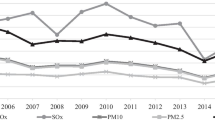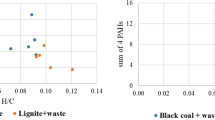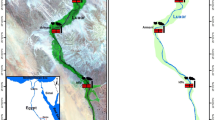Abstract
The replacement of fossil-based fuels by renewable fuels (biofuels) was proposed in the IPCC report, as an alternative to reduce greenhouse gas emission and reach out to a low-carbon economy. On this perspective, the Brazilian government had implemented a renewable energy program based on the use of ethanol in the transport sector. This work evaluates the scenario of pollutant gas emissions and particulate material that comes from the biomass burning process involved in ethanol production cycle, in the city of Campos dos Goytacazes, Brazil. The gases and particulate material emitted by sugarcane and bagasse burning processes—the last one in energy co-generation mills—were analyzed. A laboratory-controlled burning of both samples was realized in an oven with temperature ramp from 250 to 400 °C, at a regular rate of 50 °C. The gas samples were collected directly from the oven’s exhaust pipe. The particulates obtained were the residual material taken out of the burned samples: a powder with the aspect of soot. A photoacoustic spectroscopy system coupled with quantum cascade laser and electrochemical analyzers was used to measure the emission of polluting gases such as N2O, CO2, CO, NOx (NO, NO2), and SO2 in ppmv range. Fluorescent X-ray spectrometry was applied to evaluate the chemical composition of particulate material, enabling the identification of elements such as Si, Al, Ca, K, Fe, S, P, Ti, Mn, Cu, Zn, Sc, V, Cu, and Sr.









Similar content being viewed by others
References
Abrahams PW (2002) Soils: their implications to human health. Sci Total Environ 291:1–32
Allen MR, Frame DJ, Huntingford C, Jones CD, Lowe JA, Meinshausen M, Meinshausen N (2009) Warming caused by cumulative carbon emissions towards the trillionth tonne. Nature 458:1163–1166
Alves F (2006) Por que morrem os cortadores de cana? Saude e Soc 15:90–98
de Andrade SJ, Varella SD, Pereira GT, Zocolo GJ, de Marchi MRR, Varanda EA (2011) Mutagenic activity of airborne particulate matter (PM10) in a sugarcane farming area (Araraquara city, southeast Brazil). Environ Res 111:545–550
Arbex MA, Böhm GM, Saldiva PHN, Conceição GMS, Pope AC, Braga ALF (2000) Assessment of the effects of sugar cane plantation burning on daily counts of inhalation therapy. J Air Waste Manage Assoc 50:1745–1749
Atkinson R (2000) Atmospheric chemistry of VOCs and NO(x). Atmos Environ 34:2063–2101
Baird C (2002) Enviromental chemistry. W. H. Freeman and Company.
Bambynek W, Crasemann B, Fink RW, Freund HU, Mark H, Swift CD, Price RE, Rao PV (1972) X-ray fluorescence yields, auger, and Coster0Kronig transition probabilities. Rev Mod Phys 44:716–813
Bard AJ et al. (1980) Electrochemical methods: fundamentals and applications. New York: wiley.
Bielecki Z, Stacewicz T, Wojtas J, Mikołajczyk J (2015) Application of quantum cascade lasers to trace gas detection. Bull Polish Acad Sci Tech Sci 63:515–525
Bisaro A, Hinkel J (2016) Governance of social dilemmas in climate change adaptation. Nat Clim Chang 6:354–359
Le Blond JS, Williamson BJ, Horwell CJ, Monro AK, Kirk CA, Oppenheimer C (2008) Production of potentially hazardous respirable silica airborne particulate from the burning of sugarcane. Atmos Environ 42:5558–5568
Bowen JE (1969) Absorption of copper, zinc, and manganese by sugarcane leaf tissue. Plant Physiol 44(2):255–261
Brito J, Carbone S, Monteiro Dos Santos DA, Dominutti P, De Oliveira Alves N, Rizzo L, Artaxo P (2018) Disentangling vehicular emission impact on urban air pollution using ethanol as a tracer. Sci Rep 8:1–10
Brühl C, Crutzen PJ (1999) Reductions in the anthropogenic emissions of CO and their effect on CH4. Chemosphere-Global Change Science 1(1-3):249–254
Cançado JED, Saldiva PHN, Pereira LAA, Lara LBLS, Artaxo P, Martinelli LA, Arbex MA, Zanobetti A, Braga ALF (2006) The impact of sugar cane-burning emissions on the respiratory system of children and the elderly. Environ Health Perspect 114:725–729
De Carvalho Macedo I (1998) Greenhouse gas emissions and energy balances in bio-ethanol production and utilization in Brazil. Biomass Bioenergy 14:77–81
Castilho S et al (2014) Role of average speed in N2O exhaust emissions as greenhouse gas in a huge urban zone. Energy Fuel 28:4028–4032
Chen T-M, Kuschner WG, Gokhale J, Shofer S (2007) Outdoor air pollution: nitrogen dioxide, sulfur dioxide, and carbon monoxide health effects. Am J Med Sci 333:249–256
Companhia Nacional de Abastecimento (CONAB), https://www.conab.gov.br/info-agro/safras/cana. Aaccessed in June 13, 2019
Couto FM, Sthel MS, Castro MPP, da Silva MG, Rocha MV, Tavares JR, Veiga CFM, Vargas H (2014) Quantum cascade laser photoacoustic detection of nitrous oxide released from soils for biofuel production. Appl Phys B Lasers Opt 117:897–903
Cox PM, Pearson D, Booth BB, Friedlingstein P, Huntingford C, Jones CD, Luke CM (2013) Sensitivity of tropical carbon to climate change constrained by carbon dioxide variability. Nature 494:341–344
Crutzen PJ, Mosier AR, Smith KA, Winiwarter W (2008) N2O release from agro-biofuel production negates global warming reduction by replacing fossil fuels. Atmos Chem Phys 8:389–395
Dallmann T, Façanha C (2018) Environmental risks of diesel passenger vehicles in Brazil. Transp, ICCT (International Counc Clean
Dallmann TR, Kirchstetter TW, Demartini SJ, Harley RA (2013) Quantifying on-road emissions from gasoline-powered motor vehicles: accounting for the presence of medium- and heavy-duty diesel trucks. Environ Sci Technol 47:13873–13881
Dulce C, Amargo T, Superexploracion LA, Cañero T, Província LA, Michelle A, Tadeu F (2012) Mundo do Trabalho Cana Doce , Trabalho Amargo : a Superexploração Dotrabalhador Canavieiro No Município De Itaberaí- Go. 13:102–127
Dutkiewicz S, Morris JJ, Follows MJ, Scott J, Levitan O, Dyhrman ST, Berman-Frank I (2015) Impact of ocean acidification on the structure of future phytoplankton communities. Nat Clim Chang 5:1002–1006
Favory R, Lancel S, Tissier S, Mathieu D, Decoster B, Neviere R (2006) Myocardial dysfunction and potential cardiac hypoxia in rats induced by carbon monoxide inhalation. Am J Respir Crit Care Med 174:320–325
Fawcett AA et al (2015) Can Paris pledges avert severe climate change? Reducing risks of severe outcomes and improving chances of limiting warming to 2 °C. Science (80- ) 350:1168–1169
de Figueiredo EB, Panosso AR, Romão R, La Scala Jr N (2010) Greenhouse gas emission associated with sugar production in southern Brazil. Carbon Balance Manag 5:7
de França D, A, Longo KM, TGS N, Santos JC, Freitas SR, Rudorff BFT, Cortez EV, Anselmo E, Carvalho JA (2012) Pre-harvest sugarcane burning: determination of emission factors through laboratory measurements. Atmosphere (Basel) 3:164–180
Gao L, Zhang M, Han Z (2009) Model analysis of seasonal variations in tropospheric ozone and carbon monoxide over East Asia. Adv Atmos Sci 26:312–318
Gilardoni S, Massoli P, Paglione M, Giulianelli L, Carbone C, Rinaldi M, Decesari S, Sandrini S, Costabile F, Gobbi GP, Pietrogrande MC, Visentin M, Scotto F, Fuzzi S, Facchini MC (2016) Direct observation of aqueous secondary organic aerosol from biomass-burning emissions. Proc Natl Acad Sci 113:10013–10018
FAO (2007) Organisation for Economic Co-operation and Development Food and Agriculture Organization of United Nations - OCDE FAO.
Godoi RHM, Godoi AFL, Worobiec A, Andrade SJ, De Hoog J, Santiago-Silva MR, Van Grieken R (2004) Characterisation of sugar cane combustion particles in the Araraquara region, southeast Brazil. Microchim Acta 145:53–56
Gold DR, Mittleman MA (2013) New insights into pollution and the cardiovascular system: 2010 to 2012. Circulation 127:1903–1913
Hansen J, Sato M, Kharecha P, Beerling D, Berner R, Masson-Delmotte V, Pagani M, Raymo M, Royer DL, Zachos JC (2008) Target atmospheric CO2: where should humanity aim? Open Atmos Sci J 2:217–231
Hansen J, Sato M, Kharecha P, Von Schuckmann K, David J, Cao J, Marcott S, Masson-delmotte V, Prather MJ, Rohling EJ, Shakun J, Smith P (2016) Young people’s burden : requirement of negative CO2 emissions. Earth Syst Dyn 8:577–616
Hao WM, Scharffe D, Lob JM, Crutzen PJ (1991) Emissions of N2O from the burning of biomass in an experimental system. Geophys Res Lett 18(6):999–1002
Hasegawa T, Fujimori S, Takahashi K, Yokohata T, Masui T (2016) Economic implications of climate change impacts on human health through undernourishment. Clim Chang 136:189–202
Hesterberg TW, Bunn WB, McClellan RO, Hamade AK, Long CM, Valberg PA (2009) Critical review of the human data on short-term nitrogen dioxide (NO2) exposures: evidence for NO2 no-effect levels. Crit Rev Toxicol 39:743–781
Hulme M (2016) after the Paris Agreement. Nat Clim Chang 6:222–224
IBGE, Brazilian Institute of Statistics Geography (2017). Disponible: https://www.ibge.gov.br/
INDC (2017) Intended Nationally Determined Contribution Towards Achieving the Objective of the United Nations Framework Convention on Climate Change.
IPCC (2013) Fifth Assessment Report Climate Change: The Physical Science Basis. Stockholm, Sweden September
Jain N, Bhatia A, Pathak H (2014) Emission of air pollutants from crop residue burning in India. Aerosol Air Qual Res 14:422–430
Janata J, Josowicz M (2002) Conducting polymers in electronic chemical sensors. Nat Mater 2:19–24
Jenkins R (1995) Quantitative X-ray spectrometry. CRC Press New YorK
Korten I, Ramsey K, Latzin P (2017) Air pollution during pregnancy and lung development in the child. Paediatr Respir Rev 21:38–46
Landrigan PJ, Fuller R, Acosta NJR et al (2017) The Lancet Commission on pollution and health. Lancet 391:1–51
Lara LL, Artaxo P, Martinelli LA, Camargo PB, Victoria RL, Ferraz ESB (2005) Properties of aerosols from sugar-cane burning emissions in Southeastern Brazil. Atmos Environ 39:4627–4637
Lelieveld J, Evans JS, Fnais M, Giannadaki D, Pozzer A (2015) The contribution of outdoor air pollution sources to premature mortality on a global scale. Nature 525:367–371
Lesk C, Rowhani P, Ramankutty N (2016) Influence of extreme weather disasters on global crop production. Nature 529:84–87
Lima JP, Vargas H, Miklós A, Angelmahr M, Hess P (2006) Photoacoustic detection of NO2 and N2O using quantum cascade lasers. Appl Phys B Lasers Opt 85:279–284
Lloyd AC, Cackette TA (2001) Diesel engines: environmental impact and control. J Air Waste Manage Assoc 51:809–847
Macedo IC, Seabra JEA, Silva EAR (2008) Green house gases emissions in the production and use of ethanol from sugarcane in Brazil : the 2005 / 2006 averages and a prediction for 2020. Biomass Bioenergy 32:582–595
Maher BA, Ahmed IAM, Karloukovski V, MacLaren DA, Foulds PG, Allsop D, Mann DMA, Torres-Jardón R, Calderon-Garciduenas L (2016) Magnetite pollution nanoparticles in the human brain. Proc Natl Acad Sci 113:10797–10801
McGonigle AJS, Thomson CL, Tsanev VI, Oppenheimer C (2004) A simple technique power station SO2 and NO2 emissions. Atmos Environ 38:21–25
MME (2018) Ministério de Minas e Energia. Disponible: http://www.mme.gov.br/
Nova cana (2015) A cana-de-açúcar como fonte de energia elétrica. Disponible: https://www.novacana.com/
Overview of the human health and environmental effects of power generation: focus on sulfur dioxide (SO2), nitrogen oxides (NOx) and mercury (Hg) (2002)
Pacific Northwest National Laboratory (2016)
Paula RB e (2007) Projeto e Avaliação Teorica e Experimental de Sistemas de Geração de Eletricidade a Partir da Biomassa Utilizando Motores Stirling. Universidade Federal de Itajubá
Platt SM, El Haddad I, Pieber SM et al (2014) Two-stroke scooters are a dominant source of air pollution in many cities. Nat Commun 5:3749–3756
Protocolo Agroambiental do Setor Sucraenergético (2017)
Reay DS, Davidson EA, Smith KA, Smith P, Melillo JM, Dentener F, Crutzen PJ (2012) Global agriculture and nitrous oxide emissions. Nat Clim Chang 2:410–416
Reyes-Reyes A, Hou Z, van Mastrigt E, Horsten RC, de Jongste JC, Pijnenburg MW, Urbach HP, Bhattacharya N (2014) Multicomponent gas analysis using broadband quantum cascade laser spectroscopy. Opt Express 22:18299–18309
Ribeiro H (2008) Sugar cane burning in Brazil: respiratory health effects. Rev Saude Publica 42:370–376
Rocha AM, Sthel MS, De Castro MPP, Mothé GA, Silva WC, Perez VH, Da Silva MG, Miklós A, Vargas H (2014) Evaluation of nitrous oxide emitted from diesel/biodiesel blends during combustion in a diesel engine at laboratory scale by a photoacoustic spectroscopy technique. Energy Fuel 28:4028–4032
Romasanta RR, Sander BO, Gaihre YK et al (2017) How does burning of rice straw affect CH4 and N2O emissions? A comparative experiment of different on-field straw management practices. Agric Ecosyst Environ 239:143–153
Rosa LA, Navarro VL (2014) Trabalho e trabalhadores dos canaviais: perfil dos cortadores de cana da região de Ribeirão Preto (SP). Cad psicol soc trab 17:143–160
Saiki M, Santos JO, Alves ER, Genezini FA, Marcelli MP, Saldiva PHN (2014) Correlation study of air pollution and cardio-respiratory diseases through NAA of an atmospheric pollutant biomonitor. J Radioanal Nucl Chem 299:773–779
Salicio MA, Mana VAM, Fett WCR, Gomes LT, Botelho C (2016) Variáveis ambientais e níveis de monóxido de carbono exalado e carboxihemoglobina em idosos praticantes de exercício. Cien Saude Colet 21:1023–1032
Samaniego L, Thober S, Kumar R, Wanders N, Rakovec O, Pan M, Zink M, Sheffield J, Wood EF, Marx A (2018) Anthropogenic warming exacerbates European soil moisture droughts. Nat Clim Chang 8:421–426
Sánchez-ccoyllo OR, Droprinchinski L, Ynoue RY, Andrade MDF (2007) The impact on tropospheric ozone formation on the implementation of a program for mobile emissions control : a case study in São Paulo , Brazil. Environ Fluid Mech 7:95–119
Satyendra T, Singh RN, Shaishav S (2013) Emissions from crop/biomass residue burning risk to atmospheric quality. Int Res J Earth Sci 1:24–30
Schuttel M (2013) Bagaço de cana como fonte alternativa de energia.
Seddon AWR, Macias-fauria M, Long PR, Benz D, Willis KJ (2016) Sensitivity of global terrestrial ecosystems to climate variability. Nature 531:229–232
Seinfeld JH, Pandis SN (2006) Atmospheric chemistry and physics—from air pollution to climate change. Wiley-Interscience Malden, MA, USA
Silva, et al. (2015) Elemental composition of PM2. 5 in Araraquara City (Southest Brazil) during seasons with and without sugar cane burning. 6:426–434
Silva FS, Cristale J, André PA, Saldiva PHN, Marchi MRR (2010) PM2.5and PM10: The influence of sugarcane burning on potential cancer risk. Atmos Environ 44:5133–5138
Silva RA, West JJ, Lamarque JF et al (2017) Future global mortality from changes in air pollution attributable to climate change. Nat Clim Chang 7:647–651
Smith P et al (2016) Biophysical and economic limits to negative CO2emissions. Nat Clim Chang 6:42–50
Stanek LW, Sacks JD, Dutton SJ, Dubois JJB (2011) Attributing health effects to apportioned components and sources of particulate matter: an evaluation of collective results. Atmos Environ 45:5655–5663
Suarez-Bertoa R, Mendoza-Villafuerte P, Bonnel P, Lilova V, Hill L, Perujo A, Astorga C (2016) On-road measurement of NH3and N2O emissions from a Euro V heavy-duty vehicle. Atmos Environ 139:167–175
Swain DL, Langenbrunner B, Neelin JD, Hall A (2018) Increasing precipitation volatility in twenty-first-century California. Nat Clim Chang 8:427–433
Tian H et al (2016) The terrestrial biosphere as a net source of greenhouse gases to the atmosphere. Nature 531:225–228
Tilman D, Hill J, Lehman C (2006) Carbon-negative biofuels from low-input high-diversity grassland biomass. Science (80- ) 314:1598–1600
Tollefson J (2016) Brazil ratification pushes Paris climate deal one step closer.
Torquato S, Ramos R (2012) Protocolo agroambiental do setor sucroalcooleiro paulista: ações visando à preservação ambiental. Análises e Indicadores do Agronegócio, São Paulo
Townsend CL, Maynard RL (2002) Effects on health of prolonged exposure to low concentrations of carbon monoxide. Occup Environ Med 59:708–711
Trenberth KE, Fasullo JT, Shepherd TG (2015) Attribution of climate extreme events. Nat Clim Chang 6:6–11
Tsao CC, Campbell JE, Mena-Carrasco M, Spak SN, Carmichael GR, Chen Y (2012) Increased estimates of air-pollution emissions from Brazilian sugar-cane ethanol. Nat Clim Chang 2:53–57
Union of the Sugar Cane Industry (UNICA) (2018). Disponible: http://www.unica.com.br/
Veras MM, Guimarães-Silva RM, Caldini EG, P.H.N. S, Dolhnikoff MMMT (2012) Effects of particulate ambient air pollution on the murine umbilical cord and its vessels: a quantitative morphological and immunohistochemical study. Reprod Toxicol 34:598–606
Wang H-J (2018) On assessing haze attribution and control measures in China. Atmos Ocean Sci Lett 11:120–122
Wolff GT, Korsog PE (1992) Ozone control strategies based on the ratio of volatile organic compounds to nitrogen oxides. J Air Waste Manage Assoc 42:1173–1177
Xu J, Jin T, Miao Y, Han B, Gao J, Bai Z, Xu X (2015) Individual and population intake fractions of diesel particulate matter (DPM) in bus stop microenvironments. Environ Pollut 207:161–167
Zaparoli D. Papel do Bagaço e Palha. Revista Pesquisa Papesp, 263, 2018, https://revistapesquisa.fapesp.br/2018/01/16/papel-de-bagaco-e-palha/ Accessed in June 13, 2019
Zhang X, Chen X, Zhang X (2018) The impact of exposure to air pollution on cognitive performance. PNAS:1–5
Zhiqing X, Yin D, Yan Z, Yachun L, Mingliang Y, Shengming J (2009) Effects of precipitation variation on severe acid rain in southern China. J Geogr Sci 19:489–501
Acknowledgments
The authors are grateful to the Brazilian agencies of the Foundation for Research Support of the State of Rio de Janeiro (FAPERJ), National Council for Scientific and Technological Development (CNPq), Coordination of Improvement of Higher Education Personnel (CAPES) for the financial support.
Author information
Authors and Affiliations
Corresponding author
Additional information
Responsible Editor: Philippe Garrigues
Publisher’s note
Springer Nature remains neutral with regard to jurisdictional claims in published maps and institutional affiliations.
Rights and permissions
About this article
Cite this article
Sthel, M.S., Mothé, G.A., Lima, M.A. et al. Pollutant gas and particulate material emissions in ethanol production in Brazil: social and environmental impacts. Environ Sci Pollut Res 26, 35082–35093 (2019). https://doi.org/10.1007/s11356-019-06613-w
Received:
Accepted:
Published:
Issue Date:
DOI: https://doi.org/10.1007/s11356-019-06613-w




